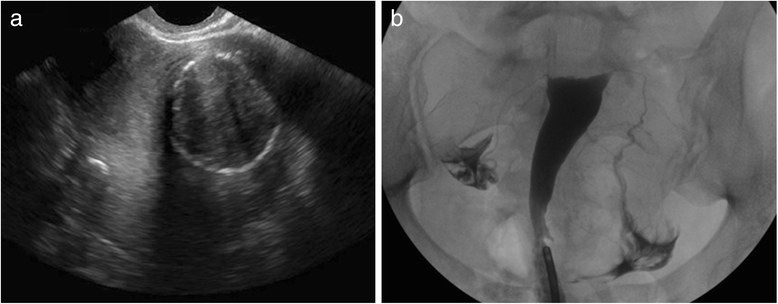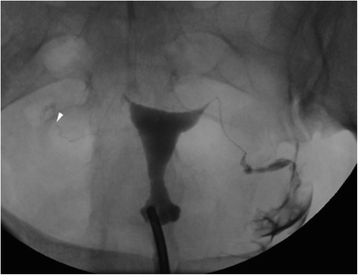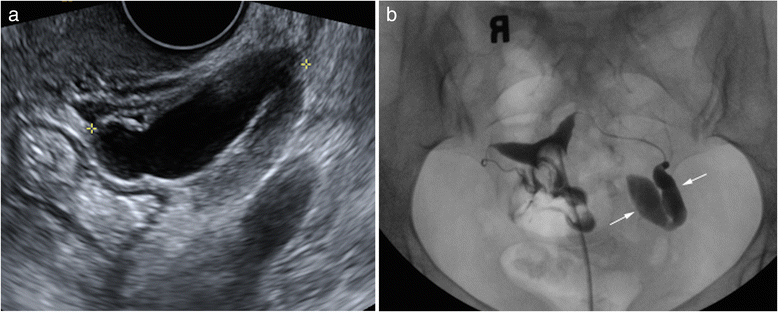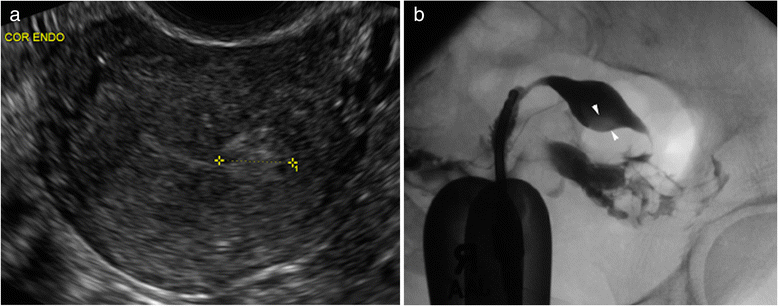Comparison of uterine and tubal pathology identified by transvaginal sonography, hysterosalpingography, and hysteroscopy in female patients with infertility
- PMID: 28620525
- PMCID: PMC5424419
- DOI: 10.1186/s40738-015-0012-3
Comparison of uterine and tubal pathology identified by transvaginal sonography, hysterosalpingography, and hysteroscopy in female patients with infertility
Abstract
Background: The causes of female infertility are multifactorial and necessitate comprehensive evaluation including physical examination, hormonal testing, and imaging. Given the associated psychological and financial stress that imaging can cause, infertility patients benefit from a structured and streamlined evaluation. The goal of such a work up is to evaluate the uterus, endometrium, and fallopian tubes for anomalies or abnormalities potentially preventing normal conception. To date, the standard method for assessing these structures typically involves some combination of transvaginal sonography (TVS), hysterosalpingography (HSG), and hysteroscopy (HSC). The goal of this review is to compare the diagnostic accuracy of TVS, HSG, and HSC for diagnosing abnormalities in infertility patients to determine if all studies are necessary for pre-treatment evaluation.
Results: We identified infertility patients prior to initiation of assisted reproductive technology who had baseline TVS, HSG, and HSC within 180 days of each other. From medical record review, we compared frequencies of each finding between modalities. Of the 1274 patients who received a baseline TVS over 2 years, 327 had TVS and HSG within 180 days and 55 patients had TVS, HSG and HSC. Of the 327, TVS detected fibroids more often than HSG (74 vs. 5, p < .0001), and adenomyosis more often than HSG (7 vs. 2, p = .02). HSG detected tubal obstruction more often than TVS (56 vs. 8, p = .002). Four (1.2 %) patients had endometrial polyps on both HSG and TVS. In the 55 patients with HSG, TVS, and HSC, HSC identified endometrial polyps more often than TVS (10 vs. 1, p = .0001) and HSG (10 vs. 2, p = .0007). TVS detected more fibroids than HSC (17 vs. 5, p < .0001). Tubal obstruction was identified more often by HSG than HSC (19 vs. 5, p < .0001).
Conclusions: TVS is superior for evaluation of myometrial pathology. HSG is superior for evaluation of tubal pathologies. Endometrial pathologies are best identified with HSC.
Keywords: Hysterosalpingography; Infertility; Transvaginal sonography.
Figures




Similar articles
-
Diagnostic accuracy of transvaginal ultrasonography and hysterosalpingography in the detection of uterine cavity pathologies among infertile women.Acta Radiol Open. 2024 May 10;13(5):20584601241252335. doi: 10.1177/20584601241252335. eCollection 2024 May. Acta Radiol Open. 2024. PMID: 38737559 Free PMC article.
-
Hysteroscopy, hysterosalpingography and tubal ostial polyps in infertility patients.J Reprod Med. 1997 Jun;42(6):337-41. J Reprod Med. 1997. PMID: 9219120
-
Comparative Analysis of Hysterosalpingography and Diagnostic Hysteroscopy Findings in Infertility Evaluation.Cureus. 2025 Apr 6;17(4):e81789. doi: 10.7759/cureus.81789. eCollection 2025 Apr. Cureus. 2025. PMID: 40330349 Free PMC article.
-
Hysteroscopy as An Investigational Operative Procedure in Primary and Secondary Infertility: A Systematic Review.Int J Fertil Steril. 2021 Apr;15(2):80-87. doi: 10.22074/IJFS.2020.134704. Epub 2021 Mar 11. Int J Fertil Steril. 2021. PMID: 33687159 Free PMC article. Review.
-
Hysterosalpingography: a reemerging study.Radiographics. 2006 Mar-Apr;26(2):419-31. doi: 10.1148/rg.262055109. Radiographics. 2006. PMID: 16549607 Review.
Cited by
-
Diagnostic accuracy of transvaginal ultrasonography and hysterosalpingography in the detection of uterine cavity pathologies among infertile women.Acta Radiol Open. 2024 May 10;13(5):20584601241252335. doi: 10.1177/20584601241252335. eCollection 2024 May. Acta Radiol Open. 2024. PMID: 38737559 Free PMC article.
-
A Successful Pregnancy Despite the Presence of an Intrauterine Fetal Bone Fragment.Case Rep Obstet Gynecol. 2019 Oct 17;2019:3064727. doi: 10.1155/2019/3064727. eCollection 2019. Case Rep Obstet Gynecol. 2019. PMID: 31772796 Free PMC article.
-
Is Hysteroscopy Prior to IVF Associated with an Increased Probability of Live Births in Patients with Normal Transvaginal Scan Findings after Their First Failed IVF Trial?J Clin Med. 2022 Feb 24;11(5):1217. doi: 10.3390/jcm11051217. J Clin Med. 2022. PMID: 35268308 Free PMC article.
-
Effect of hysteroscopy before starting in-vitro fertilization for women with recurrent implantation failure: A meta-analysis and systematic review.Medicine (Baltimore). 2019 Feb;98(7):e14075. doi: 10.1097/MD.0000000000014075. Medicine (Baltimore). 2019. PMID: 30762725 Free PMC article.
References
-
- Chandra A, Martinez GM, Mosher WD, Abma JC, Jones J. Fertility, family planning, and reproductive health of U.S. women: data from 2002 National Survey of Family Growth. Vital Health Stat. 2012;23:1–160. - PubMed
-
- Chandran A, Copen CE, Stephen EH. Infertility service use in the United States: Data from the National survey of Family Growth, 1982-2010. http://www.cdc.gov/nchs/data/nhsr/nhsr073.pdf - PubMed
LinkOut - more resources
Full Text Sources
Other Literature Sources

